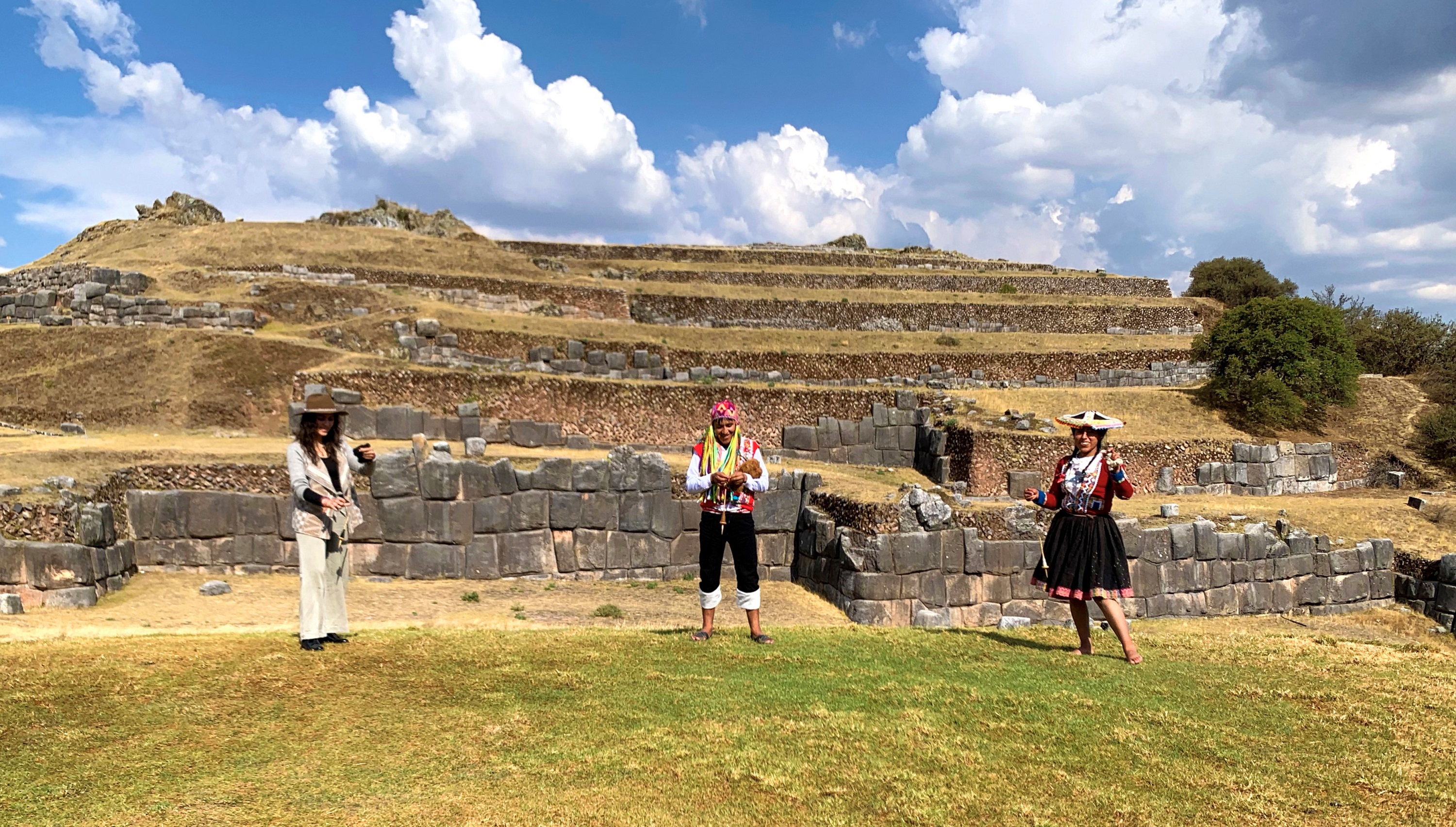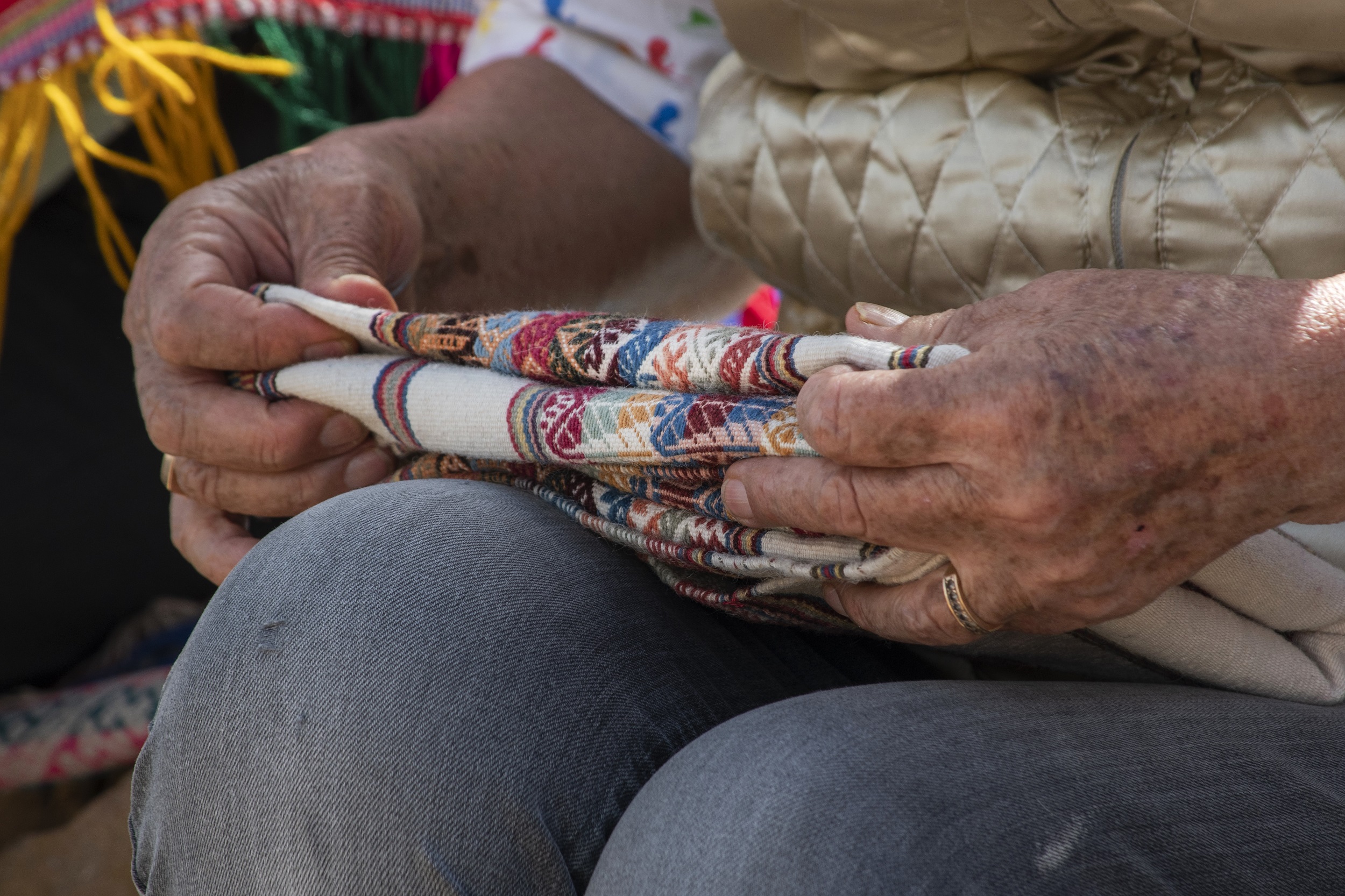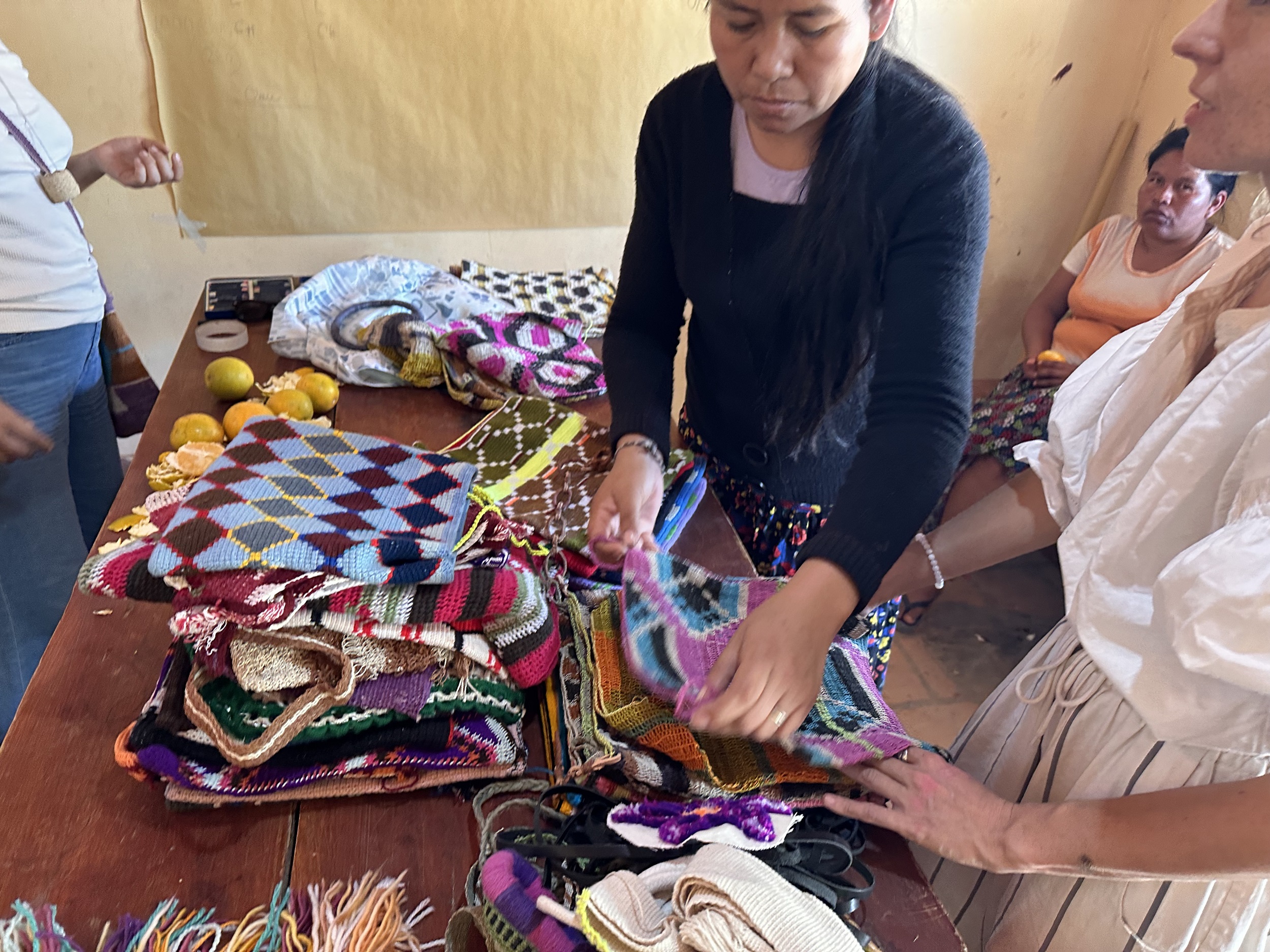Future Weavings: Artistic Experimentation and Collective Creation within Latin American Textile Traditions
past
Argentina, Guatemala, Perú
2023—II
11/30/2023 — 11/30/2023
Conclusions on the formative projects developed by of the Noqanchis Collective (integrated by Alipio Melo, Danitza Willka and María José Murillo); the Grupo Silät (represented by Andrei Fernández, Claudia Alarcón and Guido Yannitto), and a collaboration from Guatemala between Hellen Ascoli, Luisa González-Reiche and Negma Coy.
I
Hand weaving, one of the oldest crafts in the world, consists of creating a flexible surface by intertwining two systems of threads at right angles: the warp and the weft. Despite advances in the mechanization of this practice since the 18th century, the fundamental principle of weaving has remained virtually unchanged to the present day. Textiles are ubiquitous elements in our lives: from birth to death, they are in intimate relationship with our bodies, becoming constitutive elements of our l identity. Thus, more than mere utilitarian objects, they are tactile archives that transmit valuable information across generations and geographies.
Textile art comfortably inhabits a series of paradoxes that allow them to question some of the modernist binarisms surrounding artistic creation. It encompasses both amateur and expert work, handmade and industrial production, the private and the public realm, high culture and popular culture. For a long time, this ambivalent status relegated textile art to a marginal position within modern art narratives and kept it as an underexplored area of academic research. However, in recent decades, thanks to the efforts of artists and researchers, it has gained unprecedented visibility. Today, textile art is exhibited in major museums around the world and is presented without restrictions in global biennials and art fairs, as well as in commercial galleries.
The current flourishing of textiles owes to the work of a pioneering group of artists whose exploration of weaving as an expressive medium during the 1960s and 1970s spawned what is now known as "The Art Fiber Movement." This community of artists—mostly women—pushed the possibilities of the medium, which had been associated with the utilitarian and domestic spheres.
Indeed, by exploring heterogeneous technologies and materials, as well as playing with notions traditionally associated with sculpture, such as volume, balance, weight, shape, among others, they revolutionized the textile medium forever and questioned the exhibition space.
II
Artist Anni Albers is recognized as the matriarch of contemporary fiber art and creator of the modern textile. Throughout her career, Albers encouraged weavers to thoroughly study the forms and structures of Andean textiles, which in her opinion represented the pinnacle of textile art design and production of all time.1 Certainly, textiles constituted the high technology of the Andes, synthesizing philosophical and mathematical knowledge with chemical advances. They also served as the basis for the development of a macro-technology used in the construction of suspension bridges and thatched roofs. The influence of textiles in the ancient Andean civilization was so significant, that it has even been proposed to establish it as a “Textile Age,” analogous to the “Stone Age” or “Bronze Age” in the Old World.2
Albers' admiration for the Andean textile legacy is known to have influenced both her own artistic practice and her pedagogical work. However, the impact of Andean textiles on the history of modern textile art—and more broadly, on Western modernism—has often been underestimated, relegated to an incidental mention or even a footnote in the artist's bibliography.
Anni Albers’ first encounter with Andean textiles occurred at the Ethnological Museum in Berlin,3 while studying at the Bauhaus—a school founded in 1919 in the German city of Weimar, which aimed to create an aesthetic representative of modern society by merging art, crafts, and technology.
As Virginia Gardner Troy4 has pointed out, in its seminal years, the Bauhaus was influenced by a distrust of the narrative of progress through industrial development, due to the massive destruction produced by the First World War.
In this context, the handcrafted objects of non-Western societies—such as textiles—embodied the ideal of integrating art into everyday life that the Bauhaus was so eager to emulate. Anni Albers began creating works inspired by the visual language of Andean textiles as early as 1922. However, this was not an isolated practice.
According to Jonathan Griffin, the technical complexity and abstract language of these textiles fascinated many Bauhaus artists, to the point that copying their most emblematic designs5 was a frequent exercise among the students enrolled in the school's weaving workshop.6 Even around 1923, when the Bauhaus rejected ornamentation in favor of abstraction, the checkerboard and zigzag patterns common in Inca designs were incorporated into both textiles and paintings.7
In 1935, with the rise of Nazism, Anni Albers and her husband, artist Josef Albers, fled to the United States, where they joined the faculty of Black Mountain College. From there, the couple traveled extensively around southern Mexico and Guatemala, as well as South America, amassing an important collection of pre-Columbian art.8 During these travels, the artist witnessed, first-hand and for the first time, how weavers used the backstrap loom and other textile techniques of ancestral origin, which she later introduced into the curriculum of the weaving program she created at Black Mountain College. Despite this, Albers' gaze focused primarily on ancient art, neglecting the fact that this legacy is renewed daily at the hands of Latin American weavers, almost as an act of resistance.
III
The process by which Andean textiles and other significant artifacts of the native cultures of what we now call Latin America ended up in European museums, to be subsequently studied by artists, must be critically examined in the light of the present. First, it is essential to recognize that these objects arrived in Europe in the context of the consolidation of archaeology as a scientific discipline, which resulted in an unprecedented plundering of a significant part of pre-Columbian material culture.9 At the same time, it is important to mention that while many modern artists felt a deep admiration for the techniques, designs, and color combinations present in textiles—which differed markedly from the European repertoire of the early 20th century—their efforts to assimilate these influences often proved superficial and were tinged with a primitivist idealization of Andean culture. As a result, they reinforced the violent history of plunder that preceded them.
Argentine artist Cesar Paternosto analyzes this process in his book The Stone and the Thread: Andean Roots of Abstract Art.10 In the introductory chapter, Paternosto explains how many European artists and theorists hastily saw signs of a proto-modernity in textile abstractions and even ventured to suggest that they might be the starting point of an artistic progression that would culminate in 20th-century geometric abstraction. The author argues that these readings, based on formal criteria, don’t make sense in a region where a medium was never developed solely for artistic purposes. Thus, the purely artistic experience, separated from the rest of society—such as it is lived in the West and in Westernized societies—was unthinkable.11
The history of appropriations and omissions of the Andean textile legacy was partially repeated, with other nuances, in Latin American countries themselves. In an essay entitled “Hilos heterodoxos en la historia del arte: Repensando la modernidad europea desde los Andes,” Anglo-Bolivian anthropologist Denise Y. Arnold postulates that many intellectual currents and indigenist artistic traditions in Latin America, paradoxically, emerged influenced by modernist re-readings of their own tradition.12 According to Arnold, Latin American artists that embraced the Indigenous but weren’t necessarily of Indigenous origin, saw in pre-Hispanic and popular art the possibility of counteracting the identity alienation they inherited from their academic training in European fine arts. Still, they often avoided using the forms of pre-Columbian and popular art directly, because of the risk of falling into “decorative” crafts and moving away from “high art.” Given this context, the motifs and techniques of ancestral and contemporary textile pieces were reduced, once again, to the “handicrafts” category—thus, remaining on the margins of local art history narratives and the artistic education systems.
Fortunately, in recent years, things have begun to change thanks to the powerful re-readings of the textile medium arising from the “foregrounding” of Indigenous knowledge at the hands of the communities that produce it. The research advanced by Elvira Espejo, director of the National Museum of Ethnography and Folklore in La Paz, Bolivia, trained as visual artist and weaver, is a pioneer in this line. In 2022, Espejo published Yanak Uywaña: la crianza mutua de las artes,13 an extensive essay that seeks to show how artistic creation in Bolivia's textile communities is governed by the principle of “mutual nurture” (crianza mutua). “Mutual nurture” consists of recognizing the existing connections between the weavers, their raw materials, the animals, the land, the plants, and even extends to the intertwining of feeling and thinking that occurs while weaving. Under this paradigm, a community of care is threaded among the different elements involved in the process of creating a textile piece and, therefore, it is acknowledged as a living complex entity that circulates as an agent of exchange, dialogue, and mediation between the natural and sacred realms.
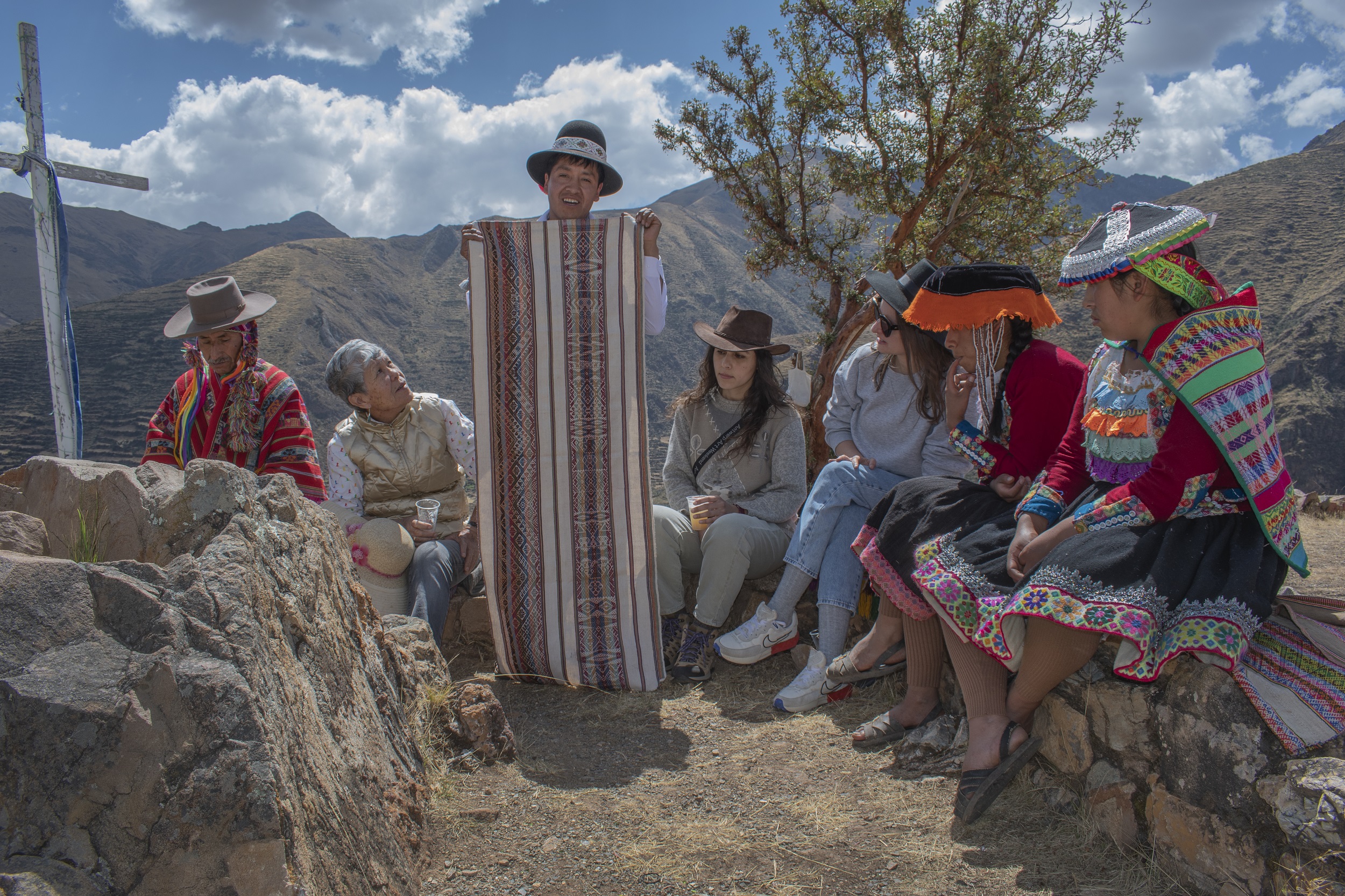
Rimanakuy: "We Do Have Eyes / Ñawiyoqmi Kanchis," by María José Murillo, Alipio Melo and Danitza Willka.
Courtesy: Noqanchis. (LA ESCUELA____ CLASSROOMS, 2023).
IV
The introduction of ancestral textile practices—kept alive by weavers in various Latin American countries—into the field of contemporary art raises profound discussions on artistic production. We have often been told that contemporary art is so plural in its intentions that artists can work in multiple media or even collaborate with someone to develop a piece in a medium they are unfamiliar with. This deepens the idea that the meaning of a work is not necessarily tied to its physical conditions, to the point that it is quite common to have conversations around a piece mentioning its medium only tangentially. Conversely, in weaving—as well as in other craft technologies—the medium is never invisible. As Elvira Espejo has rightly suggested, both the creative process and the materials used are intrinsic to the meaning of the work and have the power to interlace tradition, history, and cultural identity.
Future Weavings: Artistic Experimentation and Collective Creation within Latin American Textile Traditions brings together the most recent projects of three collectives from Peru, Argentina, and Guatemala. These collectives have been working systematically to create spaces for reflection, learning, and co-authorship among weaving artists, artists with a training in fine arts, and cultural agents—such as curators and scholars. They all share a commitment to preserving the knowledge contained in the various ancestral textile traditions across Latin America and an interest in questioning the aesthetic hierarchies that have historically separated “art” from “craft” in the region. Future Weavings features works developed by the Noqanchis collective (Cusco, Peru), composed of Alipio Melo, Danitza Willka and María José Murillo; the Silät collective (Salta, Argentina), represented by Andrei Fernández, Claudia Alarcón and Guido Yannitto, and the collaboration between Hellen Ascoli, Luisa González-Reiche and Negma Coy from Guatemala.
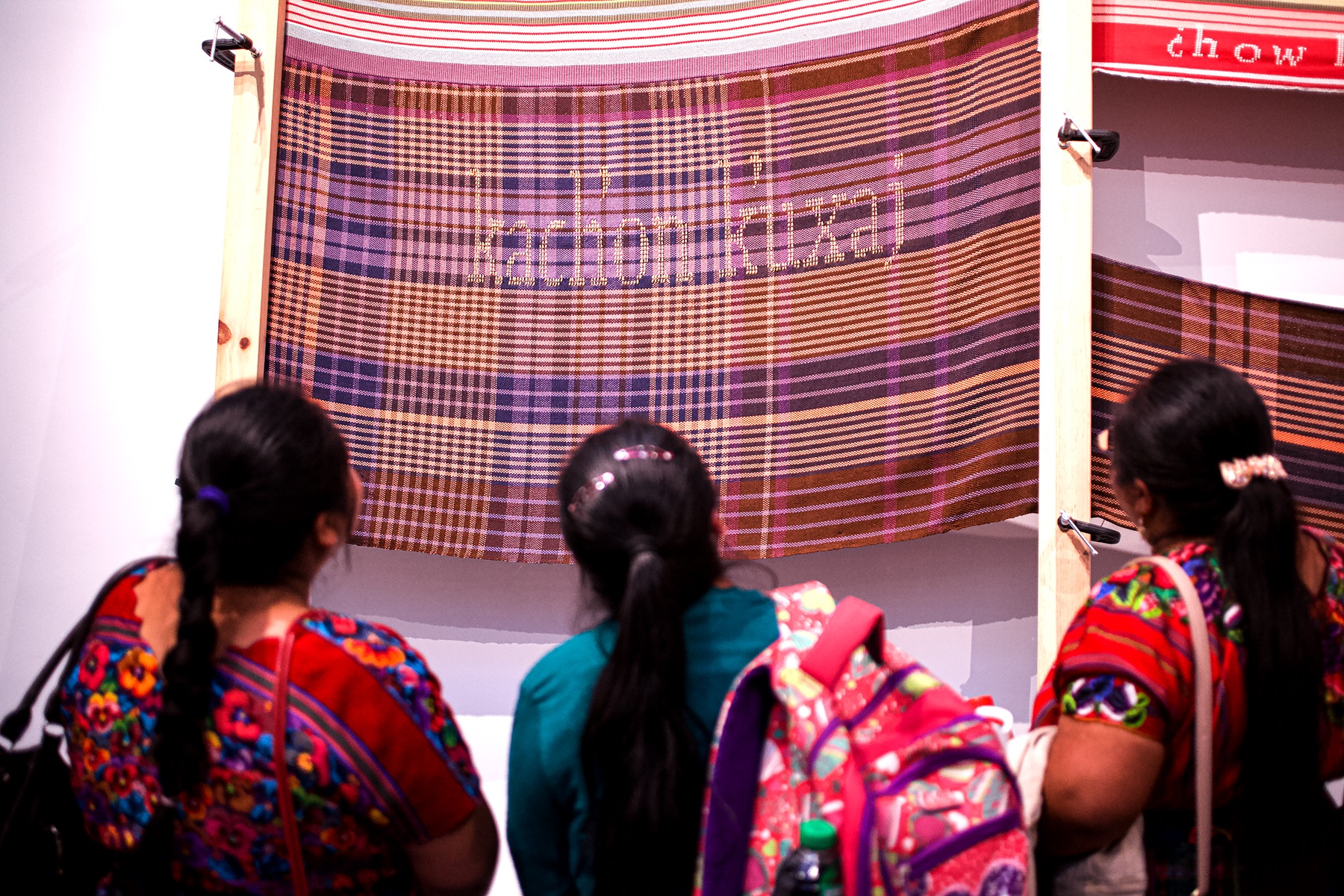
Hellen Ascoli: "Cien Tierras" (2023). Exhibition view at La Nueva Fábrica, Antigua Guatemala.
Courtesy: Hellen Ascoli.
Aware of the long history of appropriations and erasures inherited by textile art in our region, the collectives participating in this project seek to use the institutional and professional structures of the contemporary art sphere—in this specific case, LA ESCUELA___’s Classroom—for diverse yet common purposes. First, they aim to make the contemporary practices of Latin America's ancestral textile traditions visible, emphasizing how some of the Eurocentric modernist values made them unintelligible. Second, they seek to introduce relational and community-based ways of making art, based on recovered Indigenous and/or rural epistemologies and/or terms. Finally—and perhaps most importantly—these collectives intend to bring back to our present a series of narratives and experiences from which colonialism has cast us aside. As Rolando Vásquez14 sharply points out, it is a matter of overcoming the tradition of silence imposed on all the voices that cannot—or refuse to—express themselves in the Western language of fine arts.
Departing from the certainty that tomorrow is built today, Future Weavings: Artistic Experimentation and Collective Creation within Latin American Textile Traditions urges us to rethink the ways in which “academic” and “traditional” artists have collaborated in the past. The project intends to give centrality to the knowledge produced by weavers—even those rooted in the backstrap loom itself—so as to avoid falling into the trap of representing the experience of others. For instance, Ñawiyoqmi Kanchis / We Do Have Eyes, by the Noqanchis collective, is a project based on the observation that, in Quechua, when a person doesn’t know how to read or write, they use the expression manan ñawiyoqchu kani, which translates as “I have no eyes.” This statement was very disturbing for the members of the collective, especially because of the frequency with which it is used to refer to Andean craft-makers, who have created one of the most important textile art genealogies of all times since millennia. As a result, the project opened spaces to reflect on the sociocultural meaning of eyes in the Andes, the division between the dominant literate and the non-literate worlds, as well as Indigenous and diverse textile literacies. On the other hand, Los ojos del tejido wichí [The Eyes of Wichí Weaving] proposed intergenerational dialogues among weavers from the Gran Chaco area in northern Argentina. The aim was to bring forth stories around the “eyes,” that is, the gaps or empty spaces created by the stitch of the binding, when knitting with the native plant of their territory: the chaguar. Many of these testimonies, collected in collaboration with translator Demóstenes Toribio, have been compiled in a new publication that records the meaning of textile creation among the Wichí people, as they approach the contemporary art world. Finally, the collaboration between Hellen Ascoli, Negma Coy and Luisa González Reiche invites us to get involved with the backstrap loom, especially with the X and E figures that appear marking the spaces between the threads when warping. This points to the space between audiences and disappearances, which is an especially relevant issue in the Guatemalan territory.

Grupo Silät: "Los ojos del tejido wichí" [The Eyes of Wichí Weaving].
Courtesy: Guido Yannitto. (LA ESCUELA____ CLASSROOMS, 2023).
Interweaving diverse legacies and geographies, the projects comprising Future Weavings... publicly deliberate on the aesthetic exclusions, oppression, and discrimination generated by the fine arts as an artistic and cultural paradigm in a region of immense epistemic diversity such as Latin America, inviting us to understand the richness of one of the most significant textile genealogies in the world.
